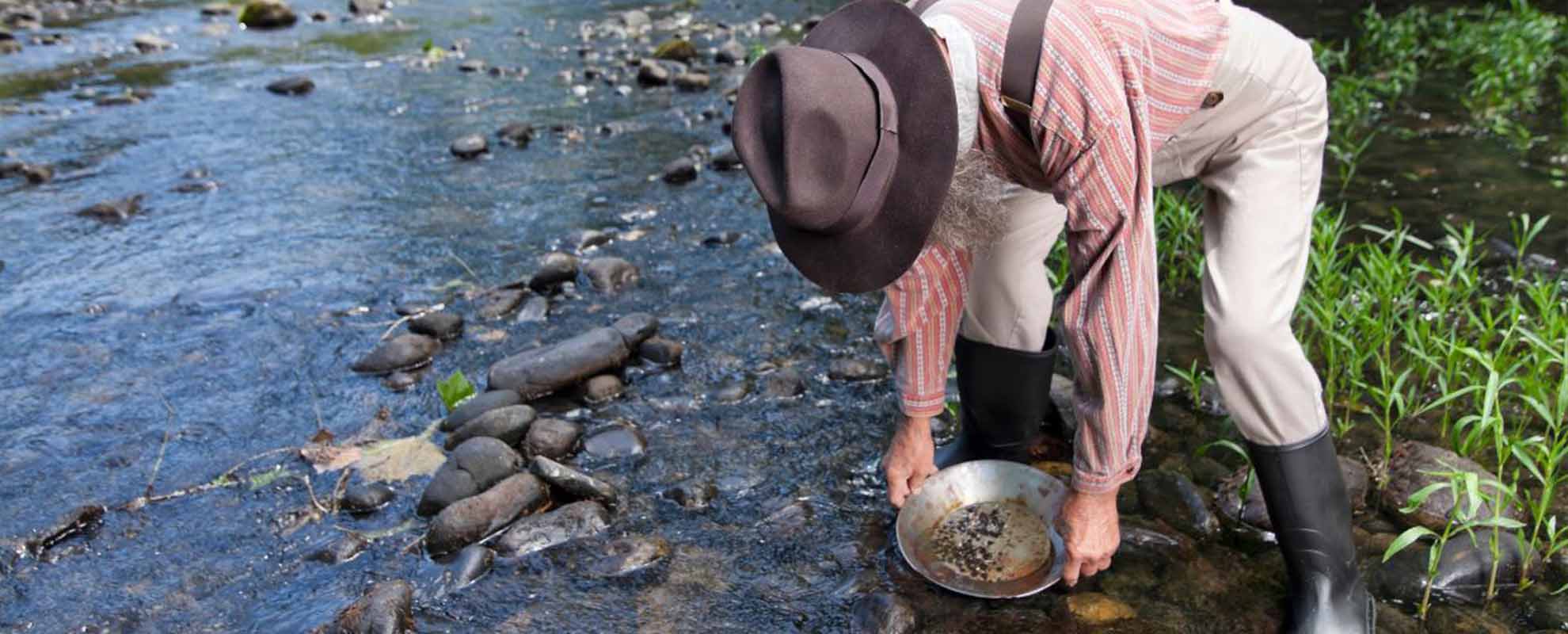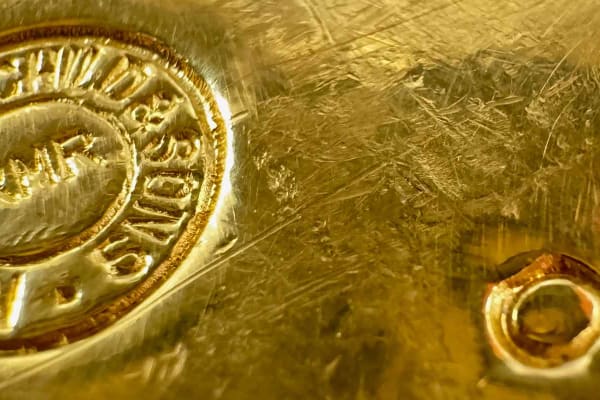
The Great Depression & The Stock Market Crash of 1929
The stock market crash of 1929 was one of the most devastating events in American history, directly bringing about the Great Depression.

If you've ever dreamed of striking it rich while enjoying the great outdoors, gold panning could be your ticket to adventure! Picture yourself nestled by a rushing stream, the sun glistening on your gold pan as you sift through gravel in search of those shiny flakes. It's not just about the thrill of the hunt; it's also a relaxing way to connect with nature. Whether you're a curious beginner or someone looking to enjoy a unique pastime, this guide will walk you through the essential tools, techniques, and tips you need to kickstart your golden journey. By following these steps, you'll soon find that even a simple hobby can lead to unexpected treasures!
Important: Before heading out, please be aware that gold panning is subject to legal restrictions in many areas, especially in the UK. Always seek permission from landowners before accessing rivers or streams, and be mindful that much of the gold-bearing land, particularly in England and Wales, is either privately owned or falls under the jurisdiction of the Crown Estate. The Crown Estate does not grant permission for recreational gold panning on any of its land. Panning without consent may be considered trespassing or unlawful mineral extraction. Additionally, some areas are protected for environmental reasons and may be off-limits entirely. Always check local laws and regulations, and pan responsibly and legally.
To pan for gold, start by selecting a suitable gold pan, ideally 12-16 inches in diameter with riffles to catch small particles. Fill the pan with gravel and water from a stream, then gently agitate the mixture to allow lighter materials to wash away while gold, being denser, settles at the bottom; repeat this process until you isolate visible gold flakes or nuggets.
At the heart of gold panning is the gold pan, which serves as your primary tool for separating gold from other materials. Typically ranging from 10 to 15 inches in diameter, these pans are designed with sloped sides and riffles that help trap fine gold particles as you swirl sediment and water within. For beginners, a basic pan usually costs around £15 to £35 ($10 to $20). This initial investment can pay off enormously, especially when you're out in the field excited about what you've found!
In addition to your gold pan, consider adding a classifier or sieve to your toolkit. A classifier allows you to screen out larger rocks and debris before you begin panning. This step reduces clutter, making it easier to focus on the finer material where gold is likely to hide. You can typically find classifiers at reasonable prices, and they are well worth it for those who want to increase their chances of striking it rich.
Another useful, yet often underappreciated tool is the snuffer bottle.
Priced at only a few pounds or dollars, this handy little device captures small flakes and nuggets of gold that might escape your grasp while panning. The snuffer bottle has a squeeze mechanism that creates suction - allowing you to gently suck up tiny pieces of gold directly from the pan without disturbing other materials. This way, you don't lose even the tiniest treasure during your search.
If your interest in gold panning shifts towards something more serious, you might want to invest in advanced tools like a portable sluice box. This piece of equipment can cost upwards of £150 / $200 and significantly speeds up the process by allowing you to process larger amounts of material more efficiently. Water flows through the sluice box, carrying away lighter materials while gold settles into grooves designated for trapping heavy particles.
Metal detectors are also available for those looking to enhance their prospecting game. A quality unit will cost a four-figure sum, but it will help you pinpoint larger nuggets beneath the surface before you even start panning, essentially accelerating your search process.
Equipping yourself with appropriate tools not only enhances your efficiency but also boosts your overall experience when panning for gold:
With these essential pieces of equipment in hand, you're better prepared for a rewarding day of panning! Understanding how to select the right gear sets the stage for maximising your time outdoors and enhancing your treasure-hunting experience.
When you select a proper pan, the world of gold panning opens up before you. Imagine standing by a bubbling brook with the sun shining through the trees - having the right tool in hand can make all the difference between fun and frustration. Your main options are plastic or metal pans, each with its unique advantages.
Plastic pans typically weigh less than a pound and will never rust, making them lightweight for hiking. However, they can struggle to capture tiny specks of gold that are oh-so-precious. On the other hand, metal pans tend to be more durable but can feel like a workout after prolonged use in water.
When selecting your pan, focus on what best fits your needs. Many beginners lean towards plastic, especially since it's easy to find and usually comes at a lower cost. You can often snag one for around £15 to £35 ($10 to $30) online or at outdoor retailers. If you're planning on dedicating serious time to gold panning or expect rougher conditions, investing in a sturdy metal pan might be worthwhile over time.
To give you an idea of how materials influence performance:
As you consider these materials, think about what environment you'll be navigating. If you're wading into rocky streams, consider how easily you'll grip the pan while maintaining your footing in swirling waters.
The size of your pan can also influence your effectiveness when panning for gold. Pans typically range from 10 inches to 18 inches in diameter. A larger pan might hold more material initially, allowing for more significant dirt separation in one go, but it can be cumbersome to handle, especially if you're wading through fast-moving water. Conversely, smaller pans are easier to manoeuvre but require more frequent refills.
Based on recent surveys among seasoned prospectors:
Riffles themselves are essential features to consider - they're grooves inside the pan designed to catch and hold onto gold flakes as you work. Essentially, think of them as little traps where your treasure waits!
Armed with the perfect pan tailored to your preferences and conditions, it's time now to explore which locations yield the best chances for finding gold on your adventure!
The very foundation of gold panning lies in selecting the right location. If you've ever felt that thrilling rush of anticipation while staring into a panning trough, much of that excitement comes from knowing you're at the right spot. Start by identifying historical hotspots where gold production was high, as these areas are often good indicators that it might still be lurking within the sediments.
Researching regions known for historic gold production should always be your first step. In the United States, California's Gold Country, Alaska's mining districts, and the riverbeds of Nevada remain classic examples, places where gold has been found for generations, and still might be today. As Jim Barlow, a seasoned prospector, once told me, "I found my best gold finds along the waterways near old mines in Nevada." His experience is a reminder that gold often hides where others once looked, and perhaps missed.
Closer to home, the UK also offers promising spots for hobbyist panners. Scotland's Leadhills and Wanlockhead are perhaps the most famous, with a long tradition of gold discoveries in their streams and burns. In Wales, the Dolgellau Gold Belt has attracted interest for centuries, while the rivers around the Tyndrum and Kildonan regions continue to turn up the occasional flake. Even parts of Cornwall and Devon, though better known for tin, have yielded traces of gold in the right conditions. These aren't just historical curiosities; they're living maps to potential finds, if you know where (and how) to look.
After identifying these historical areas, you'll want to take a closer look at analysing terrain.
To improve your chances, focus on specific features of the landscape. Look for river bends or behind large boulders; these spots can naturally trap gold particles carried by river currents. As water flows around obstacles, it slows down, allowing heavier materials like gold to settle instead of continuing downstream. Additionally, straight stretches of river where the water narrows often create deep pools that could hide precious flakes.
Use topographic maps to visualise different terrains and identify promising panning locations. These maps can show contours and depths that might not be apparent at first glance and will guide you toward the safest and most fruitful areas.
Slow-moving waters can catch fine gold while rapid streams may wash it away. This nuanced understanding of how water behaves will sharpen your prospecting skills. Engage not only with maps but also with local wisdom; joining prospecting clubs or going online can provide untapped resources and firsthand accounts from other enthusiasts.
Armed with this geographical knowledge, it's essential to prepare thoroughly before mastering practical techniques for successful outings on the water.
Panning for gold might sound simple, but there's an art to it that requires attention to detail and a few critical techniques. Each step serves a specific purpose in maximising your chances of finding those elusive gold flakes.
The process begins with digging up a mixture of gravel and dirt, commonly referred to as pay dirt, from spots you've identified as promising. Armed with your trowel or small shovel, focus on areas where history suggests gold may have settled.
Once gathered, it's time to use a classifier, a handy sieve that allows you to separate the larger rocks from finer materials efficiently. This initial separation lays the foundation for effective panning because greater concentration on smaller particles increases your likelihood of stumbling upon that coveted gold. Remember, patience is key; rushing this stage may mean losing valuable finds.
With the classified material ready, move on to the washing phase. Submerge your pan partially in water, ensuring enough liquid is present to facilitate movement without overfilling. As you begin to gently shake the pan, gravity does its work - heavier materials like gold will settle at the bottom while lighter debris floats away.
Tilt the pan slightly forward and backwards. This agitation helps wash away lighter materials over the edge while keeping the heavier bits securely nestled in the riffles of your pan. Ideally, you should see black sand starting to form at the base of your pan - that's a good sign that your gold could be close behind!
Now comes one of the most thrilling moments during panning: checking for gold. After thoroughly agitating and washing out lighter materials, you'll want to inspect what remains carefully. Gently swirl the pan, allowing any residual lighter material to float away if necessary.
Look closely at what's left - sometimes small flecks can be easily overlooked amidst other black sands or rocks. If you spot shiny metal particles nestled among the gravel, rejoice! That's your prized gold.
As these techniques become second nature, you'll become more adept at identifying gold among other minerals found in river sediments. Practice sharpens your skills and prepares you for the next stage of working with those precious finds.
Collecting those shiny little flakes you discover while panning - it's an art and a skill that can enhance your experience. The tools you use and the techniques you adopt are crucial in ensuring that you maximise your haul without losing any precious specks.
A snuffer bottle, for instance, is an invaluable tool. It operates like a small vacuum, allowing you to gently suck up tiny gold flakes while leaving behind the bulk of lighter materials in your pan. This helps prevent misplacing valuable finds as you sift through sediment.
For any larger pieces that may find their way into your pan, a pair of tweezers acts like a gentle hand, helping you pick them up carefully without risk of loss.
Consider storage options carefully to keep your hidden treasures safe during your adventures. A small glass vial or jar with a tight-sealing lid works wonders in protecting collected gold from damage. Not only does it safeguard against breakage, but it also prevents contamination with dirt and other particles.
Some seasoned prospectors opt for a leather pouch because it not only provides easy access but also adds an old-world charm to the experience.
"Collecting is just as important as finding - treat your finds with care."
As you continue to pan for gold and increase your collection, there are additional tips that can help improve your yield. For instance, always empty your snuffer bottle or storage container onto a clean surface so you can easily check for any missed flakes.
Remember to take advantage of different environments. Panning in slower sections of water and near river bends can increase your chances of finding gold, as these spots tend to trap heavier particles.
After safely storing your gathered gold, it's essential to maintain that collection so it remains safe and visible. If you're serious about preserving your treasure, consider investing in a display case - a small showcase where you can exhibit your tiny bounty in style!
This serves not just as storage but also as a way to celebrate your accomplishments. Plus, having everything organised lets you easily track how much you've gathered over time - each piece tells its own story of discovery and adventure.
Making the most of your finds lies within choosing the right tools for collection and ensuring they're stored properly. Practising these methods will turn those exhilarating moments spent searching for gold into treasures that shine brightly both in memory and material form.
With these techniques in mind, let's explore practical strategies that can enhance the overall experience and effectiveness of your gold panning journey.
Mastering the art of gold panning isn't just a matter of luck; it's a combination of learned techniques, keen observation, and a dash of creativity. First, let's discuss one of the most effective ways to improve your skills: learning various panning techniques. Watching instructional videos can provide invaluable insights into how experienced panners approach different situations.
For instance, many seasoned panners emphasise the importance of maintaining a consistent angle - approximately 30 degrees - while swirling the pan. This angle optimises the separation of lighter materials from heavier grains like gold.
Engaging with local gold panning clubs or online forums allows you to benefit from the experiences of others. These communities often share tips and tricks that aren't found in books or videos.
"Having the option to ask questions and learn from fellow enthusiasts sped up my learning curve immensely," says long-time panner Richard Moore.
Practising in controlled environments, such as setting up a sifting station at home using dirt from known gold-bearing areas, can bolster your understanding of how gold behaves in different materials.
Another vital tip is to stay patient. Gold panning is not an instant-gratification endeavour; sometimes it feels like you're sifting through endless rocks without a glimmer in sight. The good news is that patience can lead to rewards; methodical, careful work pays off over time.
Panners often recount stories of unexpected discoveries that came after hours of diligent effort. Remember also that gold not only tends to settle directly at stream beds but can often be found near bends or behind large obstructive rocks where it's been naturally deposited over time.
Don't shy away from exploring lesser-known areas as well; while it's easy to gravitate towards popular spots with historical production, sometimes the best finds occur off the beaten path. Over time, you'll develop a discerning eye for potential locations.
As you become more attuned to your surroundings, you'll begin to understand where heavier particles typically congregate - in crevices, cracks, and slower-moving waters.
Equipped with these techniques and insights, you'll be ready to maximise your results and truly appreciate the fruits of your labour as you venture further into this fascinating pursuit.
The thrill of finding gold is one thing, but the true journey begins with handling it wisely. As soon as you uncover those shiny flakes or nuggets, the excitement can leave anyone feeling a bit giddy. However, grounded decisions about your newfound treasure will help maximise its enduring value. First and foremost, weighing and assessing the worth of your find lays the foundation for what you'll do next.
Begin by weighing your gold using a precise digital scale that measures in grams. This tool is crucial because gold is traded by weight. Knowing the exact weight allows you to calculate its approximate worth based on current market prices. Regularly check financial news websites or dedicated resources that update gold prices frequently to ensure you're equipped with accurate data. Keep in mind that prices fluctuate due to various market factors; err on the side of caution and check multiple sources before making any decisions.
Once you've got a good idea of what your gold might be worth, the next step is deciding where to sell it. At Gold Traders, we specialise in buying natural gold - whether it's flakes, nuggets, or panned concentrates. We offer transparent pricing based on the live market rate and make the selling process straightforward, with same-day payments and no hidden fees. As an established and well-reviewed business, many of our customers come to us after comparing options and wanting a fair, hassle-free experience.
Of course, you might consider selling through online marketplaces like eBay, where individual buyers sometimes pay a premium for unusual or eye-catching pieces. Just keep in mind that selling this way involves fees, time, and often a bit of guesswork around pricing. For most people, especially those new to panning, working with a professional buyer like Gold Traders tends to be simpler - and ultimately more rewarding.
It's equally important to document your gold panning journey. By keeping a journal detailing your finds - including dates, locations, and weights - you'll cultivate a wealth of information over time. Pattern recognition emerges from these records, helping you identify which locations prove fruitful during different seasons or water levels. Not only does this record assist in future planning, but it also becomes a nostalgic keepsake full of tales from your adventures in pursuit of riches.
Therefore, following these steps ensures that your experiences with gold panning remain rewarding long after the initial discovery. Understanding how to weigh, sell, and record your findings transforms each success into an opportunity for growth and learning in this adventurous hobby.
Embarking on this golden journey equips you with knowledge and experience that will enrich your future planning endeavours. Happy hunting!
To maximise your chances of finding gold while panning, focus on locations with a history of gold discoveries, particularly near river bends and behind large boulders where heavier materials settle. Utilise the "scoop and shake" technique, allowing for proper stratification of materials, and always pan in layers to reduce the risk of losing gold. Studies show that over 90% of small gold flakes can be lost without careful attention to detail, so patience and finesse are key in this delicate process.
Yes, several regions around the world are renowned for gold panning. In the United States, the Sierra Nevada mountains in California are perhaps the most iconic, thanks to the 19th-century Gold Rush that drew thousands of prospectors. Alaska's rivers and creeks, the Black Hills of South Dakota, and certain areas of Colorado also continue to attract enthusiasts, with historic mining records showing millions of ounces extracted from these regions over the years. For beginners, these areas still hold potential, especially along riverbeds and near abandoned mine sites where gold may have been overlooked.
In the UK, gold panning is less widespread but still very much alive. Scotland's Leadhills and Wanlockhead, often referred to as the heart of British gold mining, are popular spots with a long-standing reputation. Wales has its own gold belt around Dolgellau, where small-scale panning is still permitted in certain rivers. You'll also find reports of gold in parts of Devon, Cornwall, and the Scottish Highlands, particularly around Tyndrum and Kildonan. While the scale is smaller than the American finds, panning in these UK locations offers an enjoyable and legal way to explore the country's hidden mineral history.
To effectively pan for gold, you will need a few essential tools: a gold pan (preferably 14 to 16 inches in diameter for beginners), a classifier (to sift out larger rocks), a shovel or trowel for digging, and a small bottle or vial for storing your gold finds. Optional but helpful equipment includes a snuffer bottle for collecting fine gold particles and tweezers for handling sensitive specimens. According to the U.S. Geological Survey, recreational gold panning can yield an average of 0.041 grams per hour, making proper equipment crucial for maximising your chances of success.
When planning to pan for gold, it's essential to understand the legal framework for the area you're visiting, as rules vary widely between countries - and even between local jurisdictions. In the United States, for example, gold panning is often permitted on public lands managed by the Bureau of Land Management (BLM), though some areas require a recreational mining permit. National parks strictly prohibit it, while certain state parks may allow panning with specific permissions. It's crucial to verify with local authorities to ensure you're within legal boundaries, especially regarding what equipment you can use - mechanical dredging, for example, is often banned in recreational settings.
In the UK, gold panning is generally legal but closely tied to land access rights. The gold in the ground is legally owned by the Crown, but panning isn't automatically prohibited, provided you have permission from the landowner where you intend to pan. In Scotland, where public access laws are broader under the Land Reform (Scotland) Act 2003, you still need the landowner's consent to remove minerals, including gold. Some areas like the Kildonan Burn have become popular for recreational panning, but recent environmental concerns have led to tighter enforcement, and even temporary bans, due to habitat disruption.
In Wales and England, gold-bearing land is often under private or corporate ownership, such as the Crown Estate or mining companies.
Note: The Crown Estate does not allow recreational panning.
This means you'll need explicit permission, and in some cases, there may be formal restrictions in place or even active security on mining sites. Using mechanised equipment or disturbing riverbeds can also breach environmental regulations.
Failing to follow the rules - whether through trespassing or unlicensed extraction - can result in fines, equipment confiscation, or legal action. So, do your research, seek permission, and treat both the land and the law with respect.
To identify gold when panning, look for its distinctive characteristics: it has a bright yellow lustre, feels heavy (density of about 19.3 g/cm³), and does not tarnish or oxidise. In contrast, fool's gold (pyrite) appears brassy yellow and crumbles easily, while other minerals like chalcopyrite have a more golden shine but can be softer. Statistically, gold's high density means that it will settle at the bottom of your pan more readily than lighter materials. Always remember to check for the malleability of the nugget; real gold can be easily shaped and doesn't break under pressure.

The stock market crash of 1929 was one of the most devastating events in American history, directly bringing about the Great Depression.

Curious about the value of a ton of gold? This page breaks down the numbers - from troy ounces to global supply - and reveals just how much one ton of pure gold is worth at today’s live prices.

Many cultures have been lured by the beauty and power that gold represents.